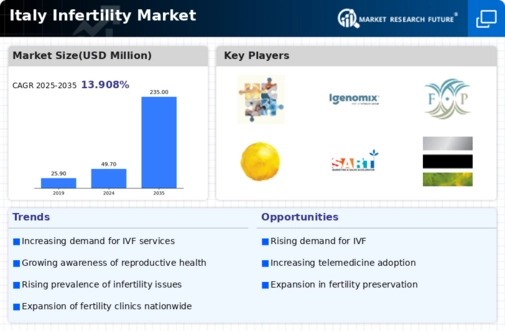Rising Infertility Rates
The increasing prevalence of infertility in Italy is a primary driver for the infertility market. Recent statistics indicate that approximately 15% of couples in Italy experience difficulties in conceiving, which has led to a heightened demand for fertility treatments and services. This trend is further exacerbated by factors such as delayed childbearing, lifestyle changes, and environmental influences. As more individuals seek assistance, the infertility market is likely to expand, with a projected growth rate of around 8% annually. This rising demand for reproductive health services is prompting healthcare providers to innovate and enhance their offerings, thereby contributing to the overall growth of the infertility market.
Increased Awareness and Education
There is a growing awareness and education regarding infertility issues among the Italian population, which serves as a crucial driver for the infertility market. Campaigns aimed at educating the public about reproductive health, fertility preservation, and available treatment options have gained traction. This increased awareness is leading to more individuals seeking consultations and treatments, thereby boosting market demand. In 2025, surveys indicate that nearly 60% of Italians are now informed about fertility treatments, compared to just 30% a decade ago. This shift in knowledge is likely to result in a more proactive approach to addressing infertility, further propelling the growth of the infertility market.
Cultural Shifts Towards Family Planning
Cultural shifts in Italy regarding family planning and childbearing are influencing the infertility market. As societal norms evolve, there is a growing acceptance of assisted reproductive technologies and a shift towards prioritizing family planning. Many couples are now considering fertility treatments as viable options rather than stigmatized choices. This cultural transformation is reflected in the increasing number of fertility clinics and services available across the country. In 2025, it is estimated that the number of fertility clinics in Italy has increased by 25% over the past five years. This expansion is likely to cater to the rising demand for infertility services, thereby driving the growth of the infertility market.
Advancements in Reproductive Technologies
Innovations in reproductive technologies are significantly influencing the infertility market in Italy. Techniques such as in vitro fertilization (IVF), intracytoplasmic sperm injection (ICSI), and preimplantation genetic testing (PGT) have revolutionized fertility treatments. The introduction of these advanced methods has improved success rates, making them more appealing to couples facing infertility challenges. In 2024, the IVF success rate in Italy was reported to be around 30%, which is expected to rise as technology continues to evolve. Consequently, the growing acceptance and utilization of these technologies are likely to drive the expansion of the infertility market, as more individuals seek effective solutions to their reproductive issues.
Regulatory Framework and Insurance Coverage
The regulatory framework surrounding fertility treatments in Italy plays a pivotal role in shaping the infertility market. Recent reforms have aimed to enhance access to fertility services, including the introduction of insurance coverage for certain treatments. As of 2025, approximately 70% of fertility treatments are partially covered by health insurance, making them more accessible to a broader segment of the population. This increased financial support is likely to encourage more couples to pursue fertility treatments, thereby stimulating growth in the infertility market. Furthermore, the establishment of clear guidelines and standards for fertility clinics is expected to enhance patient trust and satisfaction, contributing to market expansion.





















Leave a Comment